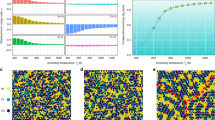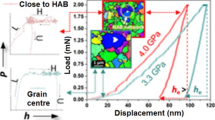Abstract
Low toughness at ambient temperatures is an inherent problem in many ordered intermetallic alloys that otherwise have attractive properties for high temperature applications. One potential explanation of low toughness is the existence of an energy barrier for crack tip dislocation emission. A model describing the energy associated with emission of a dissociated superlattice dislocation from a crack tip in ordered intermetallic alloys has been formulated. Application of the model to a wide variety of intermetallic alloys with the L12 and B2 crystal structures has revealed a correlation between the observed macroscopic fracture mode and the calculated range of slip system orientations for which emission of a dissociated superlattice dislocation at ambient temperatures is possible. Additionally, the model has been used to predict the effects of lowering the stacking fault energy, increasing the thermal energy available for thermally activated dislocation emission, and changing the active slip system. Preliminary fractographic analyses have been conducted with a chromium-modified Al3Ti alloy to verify the model predictions.
Similar content being viewed by others
References
J.R. Rice and R. Thomson, Phil. Mag. 29, 73 (1974).
M.F. Bartholomeusz and J.A. Wert, Acta Metall. et Mater., 40, 673 (1992).
M.F. Bartholomeusz and J.A. Wert, J. Mater. Res., 7, 919 (1992).
I. Baker and P.R. Munroe, in High Temperature Aluminides & Intermetallics, S.H. Whang, C.T. Liu, D.P. Pope and J.O. Stiegler (eds), MRS, Warrendale, 1990, p. 425.
D.E. Mikkola, J.P. Nic, S. Zhang and W.W. Milligan, ISIJ International, 31, 1076 (1991).
D.B. Miracle, S. Russell and C.C. Law, in High Temperature Ordered Intermetallic Alloys III, C.T. Liu, A.I. Taub, N.S. Stoloff and C.C. Koch (eds), MRS, Pittsburgh, 1989, p. 225.
R. Darolia, D.F. Lahrman, R.D. Field and A.J. Freeman in High Temperature Ordered Intermetallic Alloys III, C.T. Liu, A.I. Taub, N.S. Stoloff and C.C. Koch (eds), MRS, Pittsburgh, 1989, p. 113.
E.P. George, D.P. Pope, C.L. Fu and J.H. Schneibel, ISIJ International, 31, 1063 (1991).
J.P. Nic, S. Zhang and D.E. Mikkola, in High Temperature Ordered Intermetallic Alloys IV, L.A. Johnson, D.P. Pope and J.O. Stiegler (eds), MRS, Pittsburgh, 1991, p. 697.
S.F. Pugh, Phil. Mag., 45, 823 (1954).
W. Meng, M. Vaudin, M.F. Bartholomeusz and J.A. Wert, “Experimental assessment of a fracture mechanism model for an Al67Cr8Ti27 intermetallic alloy”, in preparation.
Acknowledgements
This work was sponsored by AFOSR under contract number AFOSR-90-0143; Dr. A. Rosenstein was the contract monitor.
Author information
Authors and Affiliations
Rights and permissions
About this article
Cite this article
Bartholomeusz, M.F., Meng, W. & Wert, J.A. The Effect of Dislocation Dissociation on Crack Tip Plasticity in L12 and B2 Intermetallic Alloys. MRS Online Proceedings Library 288, 537–542 (1992). https://doi.org/10.1557/PROC-288-537
Published:
Issue Date:
DOI: https://doi.org/10.1557/PROC-288-537




